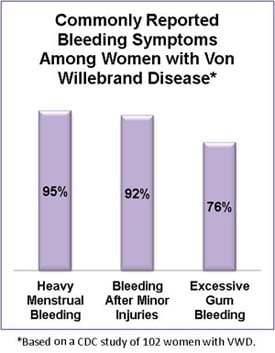Data and Statistics on von Willebrand Disease
Prevalence
- Von Willebrand disease (VWD) occurs with equal frequency among men and women, affecting up to 1% of the general population.1,2 However, women are more likely to experience symptoms of VWD because of the increased bleeding it causes during their menstrual periods, during pregnancy, and after childbirth. Between 2012 and 2016, more than 14,600 men, women, and children were seen at hemophilia treatment centers for treatment of VWD. About 2/3 were women and girls.
Diagnosis
In a CDC survey of women with VWD: [Read article]
- There was an average of 16 years between the onset of their bleeding symptoms and diagnosis of a bleeding disorder.
- Women reported an average of 6 bleeding symptoms before a diagnosis of VWD was made. Common symptoms included menorrhagia, bruising, nosebleeds, and bleeding from surgery, injury, and delivery. Menorrhagia was the most commonly reported symptom.
- To obtain the diagnosis of VWD, tests were carried out on average twice (range 1–20 times).
- 38% of women reported that they were first diagnosed by a Hemophilia Treatment Center (HTC) doctor. Among women diagnosed by a provider other than an HTC doctor, 42% were diagnosed by a hematologist, 28% by an internist or a family doctor and 19% by a gynecologist.
Complications
In a CDC study of 102 women with all types of VWD compared to 88 controls: [Read article]
- The most commonly reported bleeding symptoms among women with VWD were:
- Heavy menstrual bleeding (95%)
- Bleeding after minor injuries (92%)
- Excessive gum bleeding (76%)
- 74% of women with VWD reported excessive bleeding from several sites (e.g. nose, gum and uterus) or following several procedures or injuries (e.g. dental, surgical, childbirth and minor injury) compared to 6% of controls.
- 41% of women with VWD reported a diagnosis of migraine headaches compared with 13% of controls.
- 37% of women with VWD reported a diagnosis of arthritis compared with 15% of controls.
- 37% of women with VWD compared with 10% of controls indicated that their menstrual period limited routine work, social activities and had a negative effect on life.
- More women with VWD than controls in this study had undergone hysterectomy (25% vs. 9%).
In studies of 42 men and 38 women with Type 1 VWD (the most common form):
- The most common bleeding symptoms were heavy menstrual bleeding in women (93%) and nosebleeds in men (53%).
- 45% of women and 50% of men with VWD reported excessive bruising.
- 40% of women and 47% of men with VWD reported excessive bleeding with surgery.
- 34% of women and 29% of men with VWD reported dental bleeding.
- 21% of women and 26% of men with VWD had received a blood transfusion.
- 76% of men with VWD had been diagnosed by age 10, but 50% of women with VWD were not diagnosed until after age 12.
References
- Rodeghiero F, Castaman G, Dini E. Epidemiological investigation of the prevalence of von Willebrand’s disease. Blood. 1987 Feb;69(2):454-9.
- Werner EJ, Broxson EH, Tucker EL, et al. Prevalence of von Willebrand disease in children: a multiethnic study. J Pediatr 1993 Dec; 123(6): 893-8.
- Ragni MV, FA Bontempo, C Hassett. Von Willebrand disease and bleeding in women. Haemophilia 1999; 5:313-317.
- Ziv O, Ragni MV. Bleeding manifestations in males with von Willebrand disease. Haemophilia 2004; 10:162-8.

